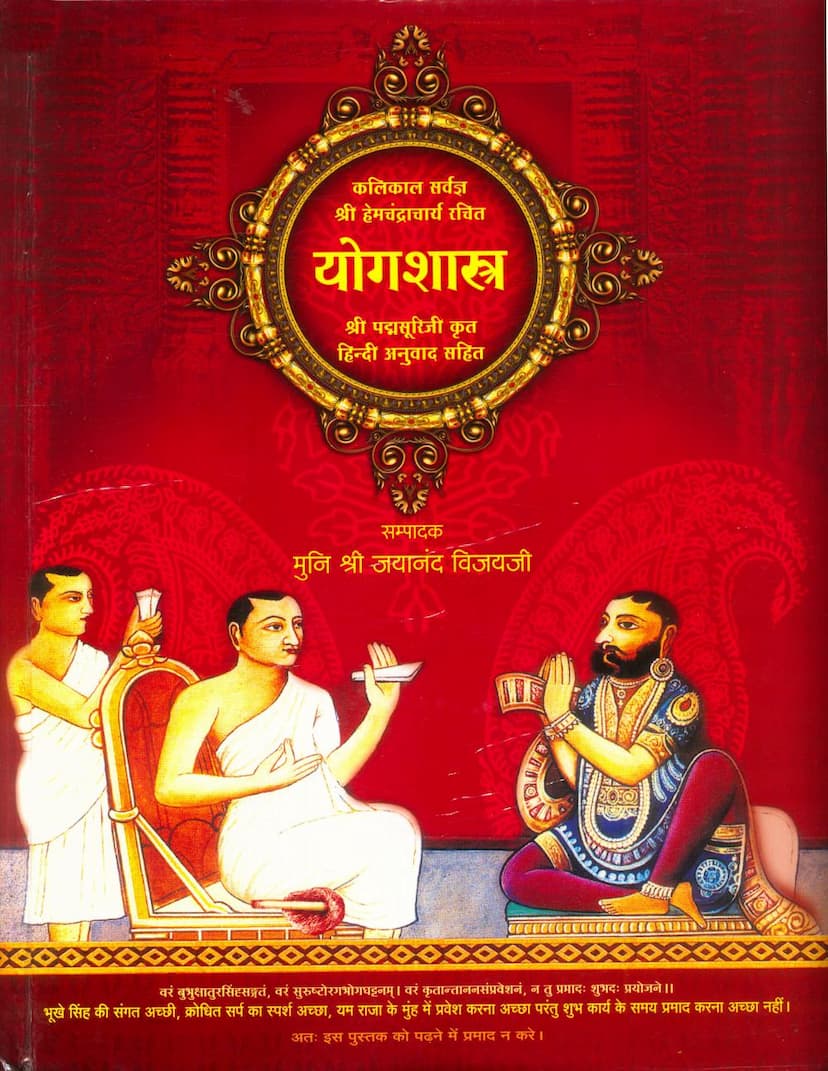Yogshastra
Added to library: September 2, 2025

Summary
Here's a comprehensive summary of the Jain text "Yogshastra" by Acharya Hemchandracharya, based on the provided pages, with an emphasis on its content and context:
Overall Context and Significance:
The text presented is the "Yogshastra," composed by the renowned Jain scholar and reformer Acharya Hemchandracharya, who lived in the 8th century. The provided material includes the original Sanskrit verses, a Hindi translation, and editorial introductions and explanations. The book is presented by Lehar Kundan Group, compiled and edited by Muni Shri Jayananadvijayji. It highlights the profound influence and esteemed status of Acharya Hemchandracharya, often referred to as "Kalikal Sarvajna" (omniscient of the Kalikala era).
Core Message of Jainism and Yoga:
The fundamental premise of the Yogshastra, as introduced in the text, is that right faith (Samyagdarshan), right knowledge (Samyagjnana), and right conduct (Samyakcharitra) are essential for achieving Moksha (liberation) in Jainism. These three elements are collectively referred to as Yoga, the path or means to liberation. The text draws a parallel between this Jain concept of Yoga and the Vedic concepts of Gyan Yoga, Karma Yoga, and Bhakti Yoga.
Structure and Content of the Yogshastra:
The "Yogshastra" is described as a comprehensive treatise composed of 12 Prakashas (chapters or sections) containing a total of 1012 verses. Acharya Hemchandracharya himself wrote a voluminous commentary, known as the "Swopajya Vrittti," spanning 12,750 verses, on his own work. The text outlines the progression through these chapters:
- First Three Prakashas: Focus on the foundational yogic practices of Yama and Niyama, which are elaborated from a Jain perspective in relation to the aforementioned three aspects of Yoga (faith, knowledge, conduct).
- Fourth Prakash: Delves into achieving union with the Supreme Self for the soul, discussing self-absorption (Atmā-ramaṇ), victory over Kashayas (passions) and Vashayas (sensual pleasures), purity of mind, sense control (Indriya-nigraha), victory over the mind (Manōvijay), equanimity (Samatva), meditation (Dhyana), the twelve Anuprekshas (contemplations), the four Bhavanas (sentiments) like Maitri (friendliness), and various Asanas (postures).
- Fifth Prakash: Covers Prāṇāyāma (breath control), mind purification, the nature of the five Prāṇas (life forces), control over Prāṇa (Prāṇavijay), Dhāraṇās (concentrations) associated with four Mandalas (circles), and knowledge of time, destiny, life, and death through Prāṇa. It also mentions Yantra, Mantra, Vidya, Lagna, Chhaya, and Upshruti for discerning time and events. It further touches upon Nadi Shuddhi (purification of nerve channels) and Parakayapravesh (entering another's body).
- Sixth Prakash: Discusses Pratyahara (sense withdrawal) and Dharana (concentration).
- Seventh Prakash: Introduces Pindastha, Padmastha, Rūpastha, and Rūpātīta (four types of meditation) and Pārthivi, Apārthivi, etc. (five types of Dhāraṇā).
- Eighth Prakash: Briefly describes the nature and method of Padmastha Dhyana.
- Ninth Prakash: Focuses on Rūpastha Dhyana.
- Tenth Prakash: Deals with Rūpātīta Dhyana.
- Eleventh and Twelfth Prakashas: Conclude with an unparalleled exposition of Dharma Dhyana and Shukla Dhyana (pure meditation), leading to Nirvikalpak Samadhi (undifferentiated meditation), Moksha, and various states of consciousness.
Acharya Hemchandracharya's Contribution:
The text emphasizes that Acharya Hemchandracharya transformed Indian yogic practices from complex Hatha Yoga techniques to a focus on self-reflection and subtle inner processes (Sahaj Yoga or Jivan Yoga). A key distinction highlighted compared to texts like Patanjali's Yoga Sutras is that while Patanjali outlines eight limbs of yoga for all stages, Hemchandracharya provides a beautiful, step-by-step yogic discipline for progressing from the stage of a follower of the path to higher spiritual states like those of householders, ascetics, and ultimately, the stage of becoming one with the Supreme Self. He intricately wove in principles of Jain philosophy, including the importance of compassion, non-violence, ethical conduct, and the understanding of karmic principles.
Key Principles and Virtues:
The initial pages also encapsulate several important ethical and philosophical teachings:
- Pratamaḍa (Negligence): The text warns against negligence, especially during auspicious or important tasks.
- The Importance of virtuous company: Associating with virtuous beings is encouraged, while avoiding the company of the heedless or those engaged in wrong conduct.
- Respect for parents: The text stresses that parents are always venerable for good people.
- Ethical conduct: Forsaking actions that go against societal norms or righteousness is advised for the wise.
- Humility: Self-praise and criticizing others are considered shameful by the virtuous.
- True wisdom: The wisdom of hypocrites is only admired by the ignorant.
Personalities and Support:
The publication acknowledges the significant support from various individuals and families, including the Lehar Kundan Group, Shri Gerodevi Jethmalji Balgota family, and many others who contributed financially. It also mentions spiritual guides like Ā. Shri Vidyachandrasurishwarji and Muni Shri Ramachandravijayji, and the editor Muni Shri Jayananandvijayji.
Acharya Hemchandracharya's Life and Works:
The text provides biographical details about Acharya Hemchandracharya, highlighting his extraordinary intellect, physical radiance, and pure conduct from a young age. It mentions his guru, Acharya Shri Devachandrasuri, and the circumstances of his initiation and subsequent appointment as Acharya. His influence on Gujarat's politics, particularly his role in guiding King Kumarpal towards Jainism and promoting principles of non-violence, is also noted. A list of his prolific works, including "Yogshastra," "Dvyashray Kavya," "Abhidhan Chintamani," "Pratiman Mimansa," and various grammatical and literary works, is provided, showcasing his multifaceted genius.
The Purpose of the Hindi Translation:
The editor, Muni Shri Jayananandvijayji, expresses his inspiration to undertake the Hindi translation of the "Yogshastra" with its extensive commentary, aiming to make the profound teachings of Acharya Hemchandracharya accessible to the general public. He also acknowledges the collaboration of Muni Shri Nemichandraji Maharaj in this endeavor.
In essence, the provided pages of "Yogshastra" serve as an introduction to a foundational Jain text on spiritual discipline and the path to liberation, deeply rooted in Jain philosophy and practice, and championed by the monumental figure of Acharya Hemchandracharya.